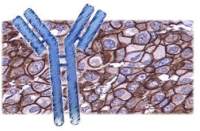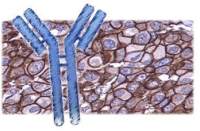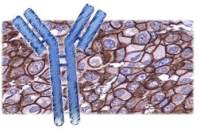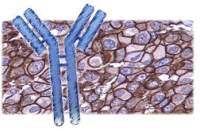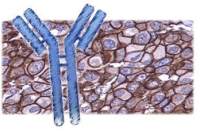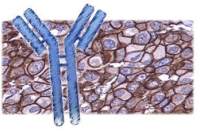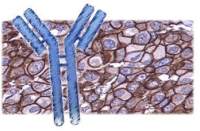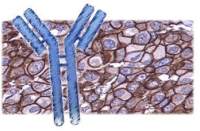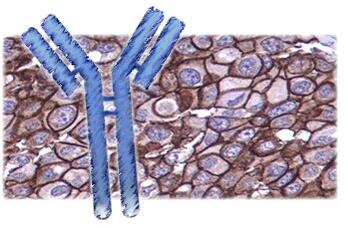
产品详情
文献和实验
相关推荐
供应商 :上海联迈生物工程有限公司
库存 :大量
靶点 :详见说明书
级别 :1
目录编号 :LM-3239R-FITC
克隆性 :多克隆
抗原来源 :Rabbit
保质期 :1年
抗体英文名 :Anti-Phospho-Cytokeratin 17(Ser44)/FITC
抗体名 :Anti-Phospho-Cytokeratin 17(Ser44)/FITC
标记物 :FITC标记
宿主 :Human, Mouse, Rat,
适应物种 :Human, Mouse, Rat,
免疫原 :详见说明书
亚型 :IGg
形态 :粉末、液体、冻干粉
应用范围 :IF=1:50-200
浓度 :1mg/ml
保存条件 :-20 °C
规格 :100ul
FITC标记的磷酸化细胞角蛋白17抗体| 英文名称 | Anti-Phospho-Cytokeratin 17(Ser44)/FITC |
| 中文名称 | FITC标记的磷酸化细胞角蛋白17抗体 |
| 别 名 | Cytokeratin 17(Phospho Ser44); Cytokeratin 17(Phospho S44); CK17 (phospho S44); CK17 (phospho Ser44); p-CK17 (Ser44); 39.1; CK 17; Cytokeratin 17; Cytokeratin-17; Cytokeratin17; K17; Keratin 17 antibody Keratin type I cytoskeletal 17; keratin, type I cytoskeletal 17; Keratin17; KRT 17; KRT17; KRT17 protein; PC; PC2; PCHC1; K1C17_HUMAN. |
| 规格价格 | 100ul/2980元 购买 大包装/询价 |
| 说 明 书 | 100ul |
| 产品类型 | 磷酸化抗体 |
| 研究领域 | 肿瘤 免疫学 转录调节因子 |
| 抗体来源 | Rabbit |
| 克隆类型 | Polyclonal |
| 交叉反应 | Human, Mouse, Rat, |
| 产品应用 | IF=1:50-200 not yet tested in other applications. optimal dilutions/concentrations should be determined by the end user. |
| 分 子 量 | 47kDa |
| 性 状 | Lyophilized or Liquid |
| 浓 度 | 1mg/ml |
| 免 疫 原 | KLH conjugated Synthesised phosphopeptide derived from human CK 17 around the phosphorylation site of Ser44 |
| 亚 型 | IgG |
| 纯化方法 | affinity purified by Protein A |
| 储 存 液 | 0.01M TBS(pH7.4) with 1% BSA, 0.03% Proclin300 and 50% Glycerol. |
| 保存条件 | Store at -20 °C for one year. Avoid repeated freeze/thaw cycles. The lyophilized antibody is stable at room temperature for at least one month and for greater than a year when kept at -20°C. When reconstituted in sterile pH 7.4 0.01M PBS or diluent of antibody the antibody is stable for at least two weeks at 2-4 °C. |
| 产品介绍 | background: The protein encoded by this gene is a member of the keratin family. The keratins are intermediate filament proteins responsible for the structural integrity of epithelial cells and are subdivided into cytokeratins and hair keratins. The type I cytokeratins consist of acidic proteins which are arranged in pairs of heterotypic keratin chains. Unlike its related family members, this smallest known acidic cytokeratin is not paired with a basic cytokeratin in epithelial cells. It is specifically expressed in the periderm, the transiently superficial layer that envelopes the developing epidermis. The type I cytokeratins are clustered in a region of chromosome 17q12-q21. This gene encodes the type I intermediate filament chain keratin 17, expressed in nail bed, hair follicle, sebaceous glands, and other epidermal appendages. Mutations in this gene lead to Jackson-Lawler type pachyonychia congenita and steatocystoma multiplex. [provided by RefSeq, Aug 2008]. Function: May play a role in the formation and maintenance of various skin appendages, specifically in determining shape and orientation of hair. May be a marker of basal cell differentiation in complex epithelia and therefore indicative of a certain type of epithelial 'stem cells'. May act as an autoantigen in the immunopathogenesis of psoriasis, with certain peptide regions being a major target for autoreactive T-cells and hence causing their proliferation. Required for the correct growth of hair follicles, in particular for the persistence of the anagen (growth) state. Modulates the function of TNF-alpha in the specific context of hair cycling. Regulates protein synthesis and epithelial cell growth through binding to the adapter protein SFN and by stimulating Akt/mTOR pathway. Involved in tissue repai. Subunit: Heterodimer of a type I and a type II keratin. KRT17 associates with KRT6 isomers. Interacts with TRADD and SFN. Subcellular Location: Cytoplasm. Tissue Specificity: Expressed in the outer root sheath and medulla region of hair follicle specifically from eyebrow and beard, digital pulp, nail matrix and nail bed epithelium, mucosal stratified squamous epithelia and in basal cells of oral epithelium, palmoplantar epidermis and sweat and mammary glands. Also expressed in myoepithelium of prostate, basal layer of urinary bladder, cambial cells of sebaceous gland and in exocervix (at protein level). DISEASE: Defects in KRT17 are a cause of pachyonychia congenital type 2 (PC2) [MIM:167210]; also known as pachyonychia congenital Jackson-Lawler type. PC2 is an autosomal dominant ectodermal dysplasia characterized by hypertrophic nail dystrophy resulting in onchyogryposis (thickening and increase in curvature of the nail), palmoplantar keratoderma and hyperhidrosis, follicular hyperkeratosis, multiple epidermal cysts, absent/sparse eyebrow and body hair, and by the presence of natal teeth. Defects in KRT17 are a cause of steatocystoma multiplex (SM) [MIM:184500]. SM is a disease characterized by round or oval cystic tumors widely distributed on the back, anterior trunk, arms, scrotum, and thighs. Note=KRT16 and KRT17 are coexpressed only in pathological situations such as metaplasias and carcinomas of the uterine cervix and in psoriasis vulgaris. Similarity: Belongs to the intermediate filament family. Database links: Entrez Gene: 3872 Human Entrez Gene: 16667 Mouse Entrez Gene: 287702 Rat Omim: 148069 Human SwissProt: Q04695 Human SwissProt: Q9QWL7 Mouse SwissProt: Q6IFU8 Rat Unigene: 2785 Human Unigene: 14046 Mouse Unigene: 106755 Rat Important Note: This product as supplied is intended for research use only, not for use in human, therapeutic or diagnostic applications. 结构蛋白(Structural Proteins) 常用于肿瘤细胞的分化、增殖及转移方面的研究。 |

上海联迈生物工程有限公司
品牌商实名认证
钻石会员
入驻年限:8年

